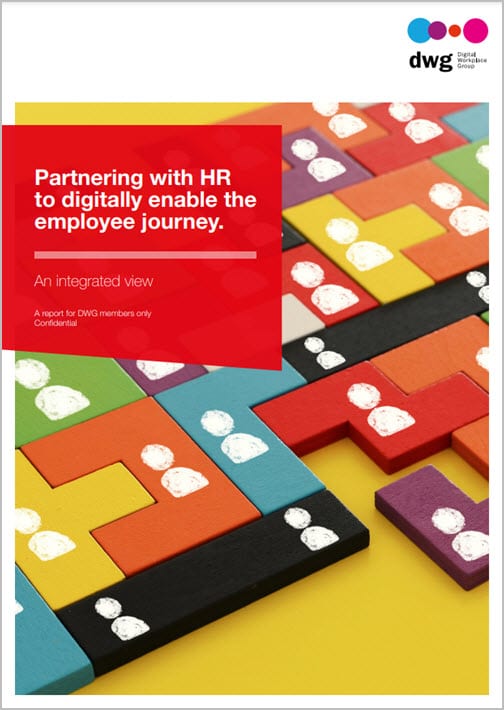Why HR is the essential digital workplace partner

Maturity is the act of knowing when and how to behave at the right time and in the right place. Maturity is subjective. Maturity is a fluid state. Just as there is no one path to maturity for a human being, there is no one path towards digital maturity for an organization. The quest for digital maturity is not clear cut or straightforward. The quest is under continuous scrutiny and revision. The quest is occasionally derailed by unforeseen circumstances. New paths are sought out; old paths reflected upon. Paths bifurcate and challenge our resources and assumptions. Digital transformation is not linear. In fact, the journey towards digital transformation can be quite complicated – one step forward and two steps back.
An area of an organization’s digital ecosystem that has undergone significant transformation is that of the digital workplace. There are many ways to assess an organization’s digital maturity, one of which is to gauge the organization and flow of people, projects, and ideas within an organization’s digital workplace. The digital workplace reflects what an organization considers to be important, the way it strategically plans, how it operates from the inside-out, and its ability to balance and blend people, processes, and technologies.
The maturity of a digital workplace is evaluated based on how standardized and predictable its practice and benefits of integration are. To ensure consistency of communication, collaboration and connection, practices (a foundation for learning from common measures and experiences) and processes (to statistically control variation) are integrated into the DNA of the digital workplace.
Just as there are numerous ways to navigate through a physical city—taking short cuts or the scenic route—so there are also multiple paths to maneuver through the digital workplace. And, every move made, every twist and turn, has consequences. Digital efforts championed by lone innovative thinkers and change agents may not get the traction needed to support the investment. The journey of digital workplace evolution or transformation requires a coalition of people and teams across the organization.
In this DWG report, Partnering with HR to digitally enable the employee journey, we consider how might business representatives and technologists strive to discover, design, build and continually improve the employee journey by working together to establish a common language, technology foundation and governance model to provide the right experience at the right time for all employees? We examine the role of Human Resources (HR) in promoting and practicing an integrated view of how the digital workplace is defined, developed, and implemented. A case study from Prudential Financial demonstrates the pivotal role HR plays in the enablement of the employee experience.
It is only by establishing consistent communication practices that collaboration amongst departments in the organization may flourish, and people, processes and technologies are connected. The report breaks down how these three pillars are critical when partnering with HR and any other departments or teams too.

Communication: Establishing a common language
Just as there is no one department that owns the digital workplace, there is no one area that owns the employee experience. Rather, several areas across the organization take turns in being responsible, accountable, consulted, and informed when bringing the employee experience to life through the maturation of the digital workplace.
Organizing a coalition for the co-creation, co-design, and co-management of the digital workplace requires a common language for understanding, using, creating, and managing. In this report, we identify how you might develop healthy communication practices by determining areas of focus and investment, cultivating cross-functional communication, and exploring trends and patterns. HR’s understanding of the employee journey, combined with the expertise of other business areas and the organization’s technology function, will help create fit-for-purpose solutions that could not be developed exclusively by any one business or technology group.
Collaboration: Serve up the right information at the right time to take action
Collaboration can start to happen once methods and boundaries for safe and effective cross-functional communication have been established. Planning and implementation procedures and practices are aligned when there’s a shared strategy, common language, and integrated approaches. These methods and boundaries foster trust between digital workplace and employee experience stakeholders and product teams.
Healthy collaboration practices are supported with iterative ways of working and are designed to address the complexity of our digital workplaces, so that we might build more resilient digital workplace environments and experiences. HR teams are not only concerned with integrating systems and processes to provide a frictionless experience but must also work with technology partners to ensure the technologies used are easy to understand, access and are not just usable, but useful.
Connection: Joining people, processes, and technologies around a shared strategy
As defined by the Cambridge University Dictionary, integration is the “process of combining two or more things into one”, as well as “the process of becoming part of a group of people”. The idea of connecting one technology with another is nothing new, but integrating people, processes, and technologies across multiple areas of the organization to create a marketplace of people, projects and ideas is still far from mainstream for many organizations.
When communication and collaboration pillars are in place, organizations may then begin connecting people, processes, and technologies as part of an “ecosystem approach” to assemble a package of solutions that directly meet the needs of the workforce. Ensuring HR has a place within the product team and at the steering committee “table” is the first step to strengthening a people-first approach to digital workplace and employee experience design and implementation.
Connecting all the dots to visualize and understand what is included in an organization’s ecosystem takes time. There will always be a new tool, platform or system that promises features and functionalities to tempt a product team or organization to forget or disregard a governance model or agreed-upon technology foundation layer. In this report, we feature the journey of Prudential Financial to create a more connected experience for its employees.
Consider how this research may spark a dialogue within your organization about how we effectively gauge and build consistent and cohesive employee digital environments and experiences. The more we know about people, projects, and ideas flowing in and out of our organizations, the more mature our organizations will become. This maturity will help us be better prepared to participate in coalition-building conversations and test and learn various tools and methods to evolve our use of digital workplace technologies.
Download the report excerpt

Partnering with HR to digitally enable the employee journey
Get access to the full report and 85+ other best practice digital workplace reports
DWG members have access to this full report, which forms part of DWG’s best practice Research Library of 85+ reports covering key areas such as strategy and governance, personalization, user experience and change management for intranets and digital workplaces.
Contact us to learn how to gain access to this library via DWG membership.
About the author

By day, Dr Lauren ‘L’ Vargas is a digital dragon wrangler with 20 years experience assisting organizations with their community and communication strategies. Vargas is a consultant affiliated with DWG, an independent researcher and consultant of Your Digital Tattoo, as well as, a ‘One by One’ Research Associate with the University of Leicester – delivering a “practical approach to building digital literacies within specific museum contexts” for UK and US museums. Dr Vargas was previously named by the Economist Intelligence Unit as one of the top 25 social business leaders.
Categorised in: Collaboration, Content management, Digital communications, Digital employee experience, Digital workplace, Employee experience, HR, HR intranets, Internal communications
